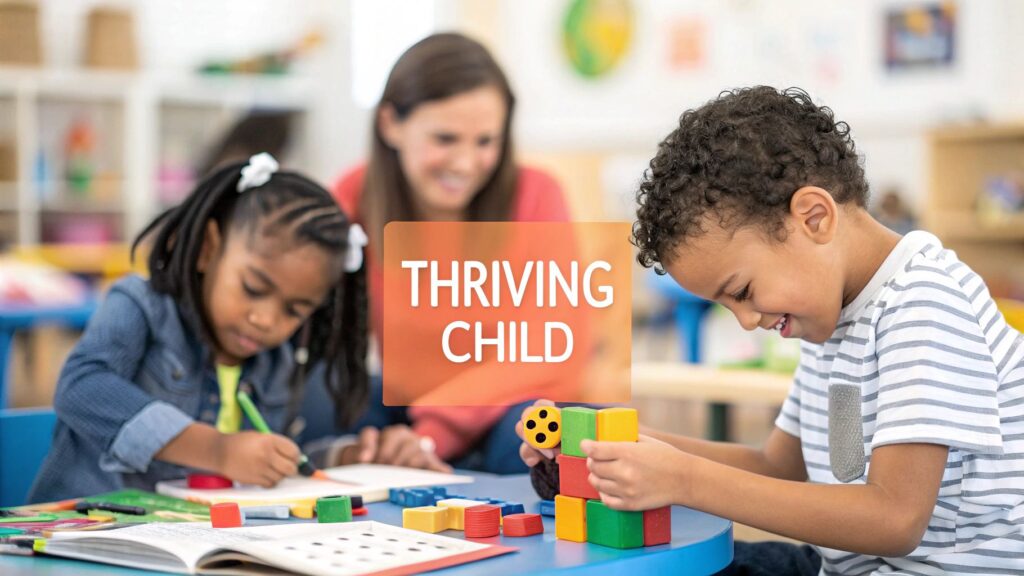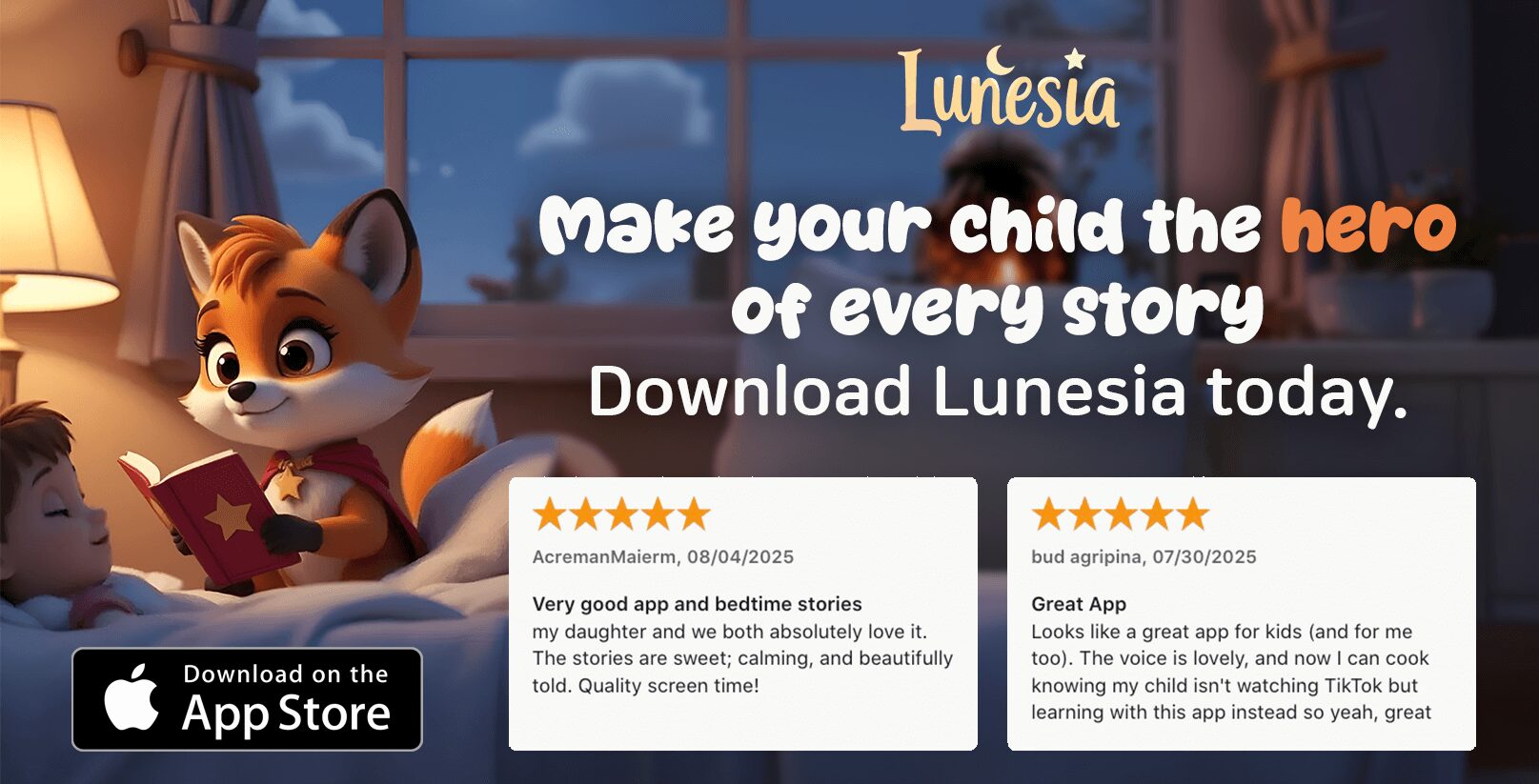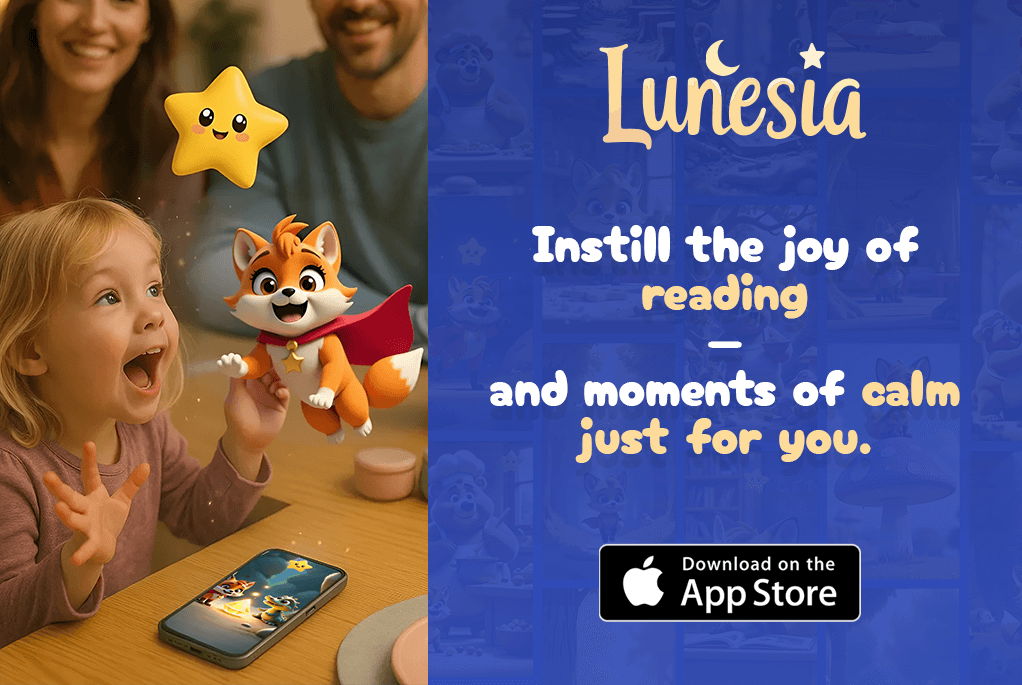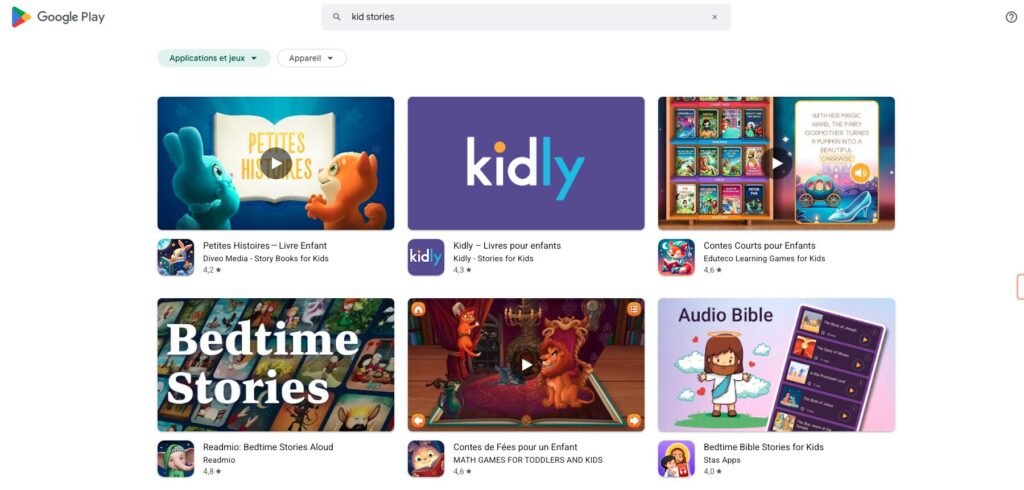Ever feel like you’re guessing your way through parenting? One minute you're a superhero, the next you're negotiating with a tiny dictator over the color of their socks. You're not alone in this beautiful chaos. What if the secrets to a calmer, more connected family life weren't secrets at all, but proven strategies from child development experts?
This guide is your roadmap, your coffee-chat with a friend who's done the research. We’re diving into the most effective early childhood education best practices, translating them from the classroom right into your living room. Wondering how to turn everyday moments into powerful learning opportunities that help your child build confidence, kindness, and problem-solving skills? Part of creating this secure foundation involves being prepared for anything, which includes knowing crucial safety skills like life-saving infant CPR techniques.
These strategies aren't just about managing tantrums; they're about nurturing a curious, emotionally intelligent, and resilient thinker. Imagine turning a challenging moment into a lesson in empathy with a simple story, or transforming playtime into a powerful brain-building exercise. Ready to turn frustration into connection and make every day a little more peaceful and a lot more meaningful? Let's begin.
1. Play-Based Learning: The Superpower Hiding in Plain Sight
What if your child’s messy, noisy, block-tower-crashing playtime was actually the most important work they could be doing? It is. Play-based learning isn’t just about having fun; it’s how children’s brains are wired to understand complex ideas, solve problems, and learn to get along with others. This foundational approach is a cornerstone of early childhood education best practices.
Did you know a 2022 study by Cambridge University confirmed that guided play helps children learn skills like math and spatial awareness just as effectively as direct instruction? It transforms their natural curiosity into a powerful engine for growth. The next time you see a living room fort, you’re not just seeing blankets and pillows; you’re seeing the headquarters of a future innovator.
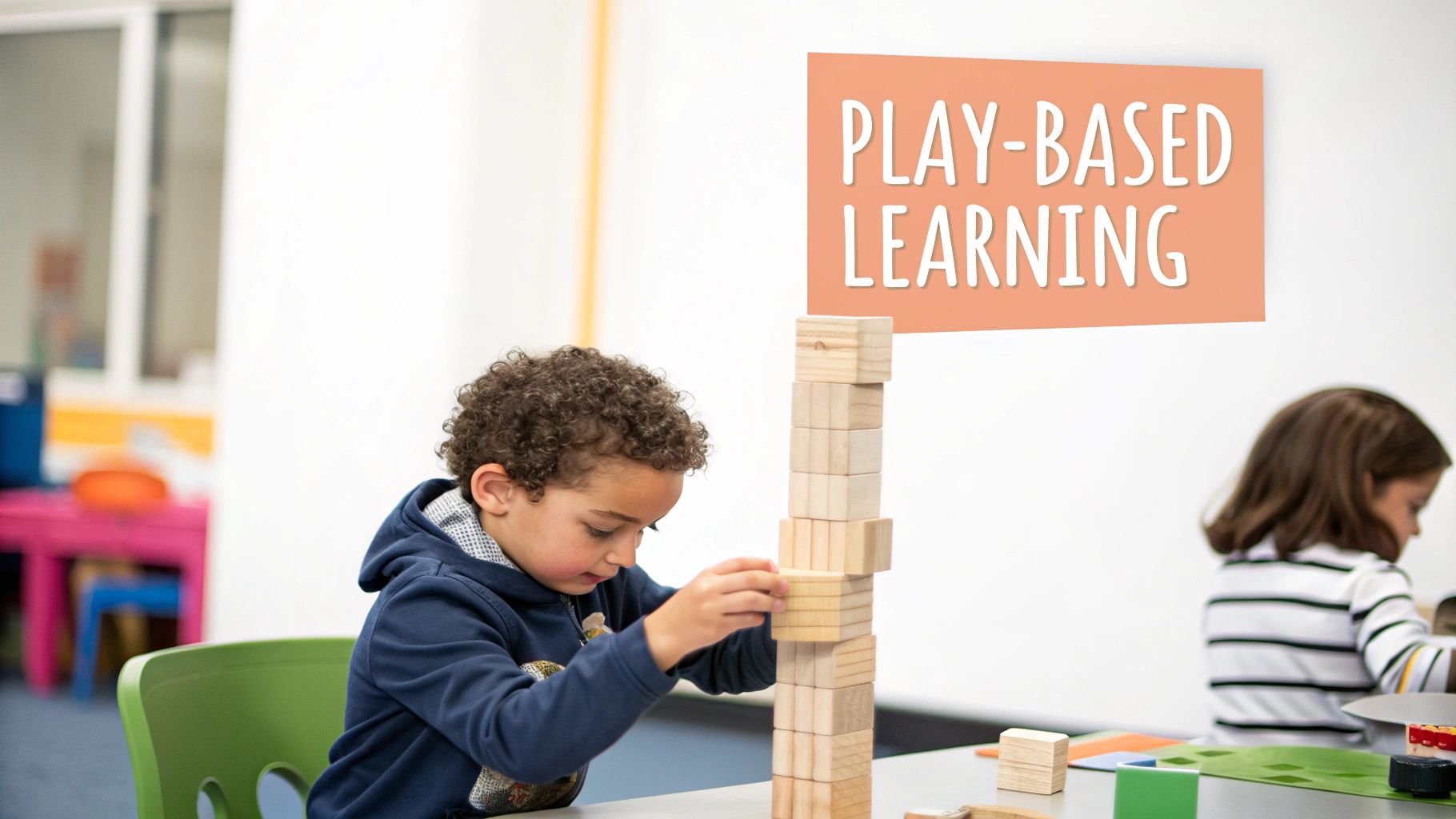
How to Nurture Play-Based Learning
How can you unlock this superpower at home? This approach thrives when children feel free to explore, experiment, and even fail in a supportive environment. Think of the world-renowned Reggio Emilia schools, where projects are driven entirely by student curiosity, or Forest Kindergartens, where nature itself is the classroom.
For children, especially those with unique learning styles, play is non-negotiable for development. You might find valuable insights in research on why children with ADHD benefit from play.
Here are some practical tips you can use today:
- Create a "Yes" Space: Designate an area with safe, open-ended materials like blocks, art supplies, and dress-up clothes where your child is free to explore without constant restrictions. Think of it as their creative lab.
- Ask "I Wonder" Questions: Instead of quizzing them ("What color is that?"), spark their curiosity. Ask, "I wonder what would happen if we added another block?" or "Tell me about the brave knight in your story."
- Be a Sportscaster for Their Play: Narrate their actions to build their vocabulary. "Wow, you are carefully balancing that green block on the blue one. It's a very tall, sturdy tower!"
2. Scaffolding and the Zone of Proximal Development: Building Bridges to Learning
Have you ever helped your child solve a puzzle by finding the corner pieces first? You were scaffolding their learning without even realizing it. This powerful technique is about providing just enough support to help a child tackle a task that’s slightly beyond their independent reach.
Why is this so effective? It’s not about giving them the answers; it’s about building a temporary support structure that you can gradually remove as their skills grow. It's one of the most effective early childhood education best practices because it empowers children to stretch their abilities and build confidence. Instead of feeling frustrated, they feel the thrill of accomplishment.
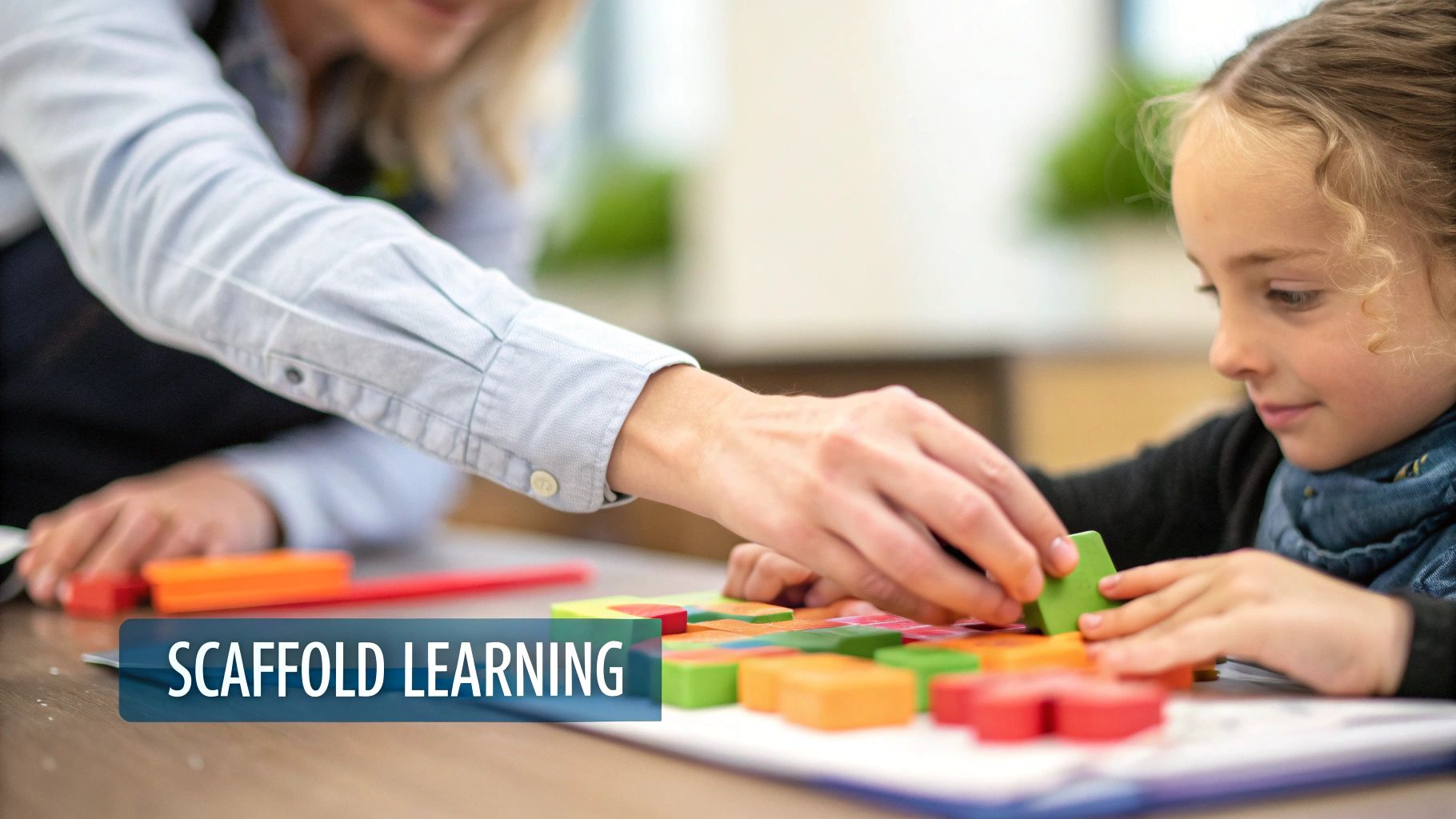
How to Build Learning Scaffolds
The key is to meet your child where they are and build a bridge to where they need to go. This approach is beautifully woven into the design of interactive storytelling apps like Lunesia. When a child faces a difficult choice in a story—like whether to share their magical berries or keep them—the narrative offers subtle hints and supportive characters. This guidance scaffolds their decision-making, teaching them to consider consequences and think critically in a safe, engaging world.
For you, this is a game-changer. You can offer your child a meaningful adventure knowing they are being gently guided toward greater resilience and problem-solving, all while you enjoy a well-deserved moment to yourself without a shred of guilt.
Here’s how to apply this at home:
- Think Out Loud: When building with blocks, say, "I'm putting the big blocks on the bottom to make a strong base so it won't fall over." This shows them the 'how' and 'why' behind your actions.
- Give a Hint, Not the Answer: If they're struggling to write their name, don't write it for them. Ask, "What sound does your name start with? Let’s find the letter that makes that sound."
- Break Down Big Tasks: "Clean your room" is overwhelming. Try, "Let's race to see who can put all the cars in their basket first!" This turns a huge job into a series of fun, manageable steps.
3. Multi-Sensory Learning Approaches: Engaging All the Senses
Why do young children touch everything in sight? It’s not to drive you crazy; it’s because their brains are built to learn by seeing, hearing, touching, and moving. Multi-sensory learning is one of the most powerful early childhood education best practices because it engages multiple senses at once, creating stronger, more memorable brain connections.
This isn’t new. Maria Montessori’s famous sandpaper letters, which allow children to feel the shape of a letter while seeing it, is a classic example. When a child learns the letter 'B' by seeing it, tracing its shape with their finger, and saying the sound aloud, the information is stored in several parts of their brain. This is learning that truly sticks.
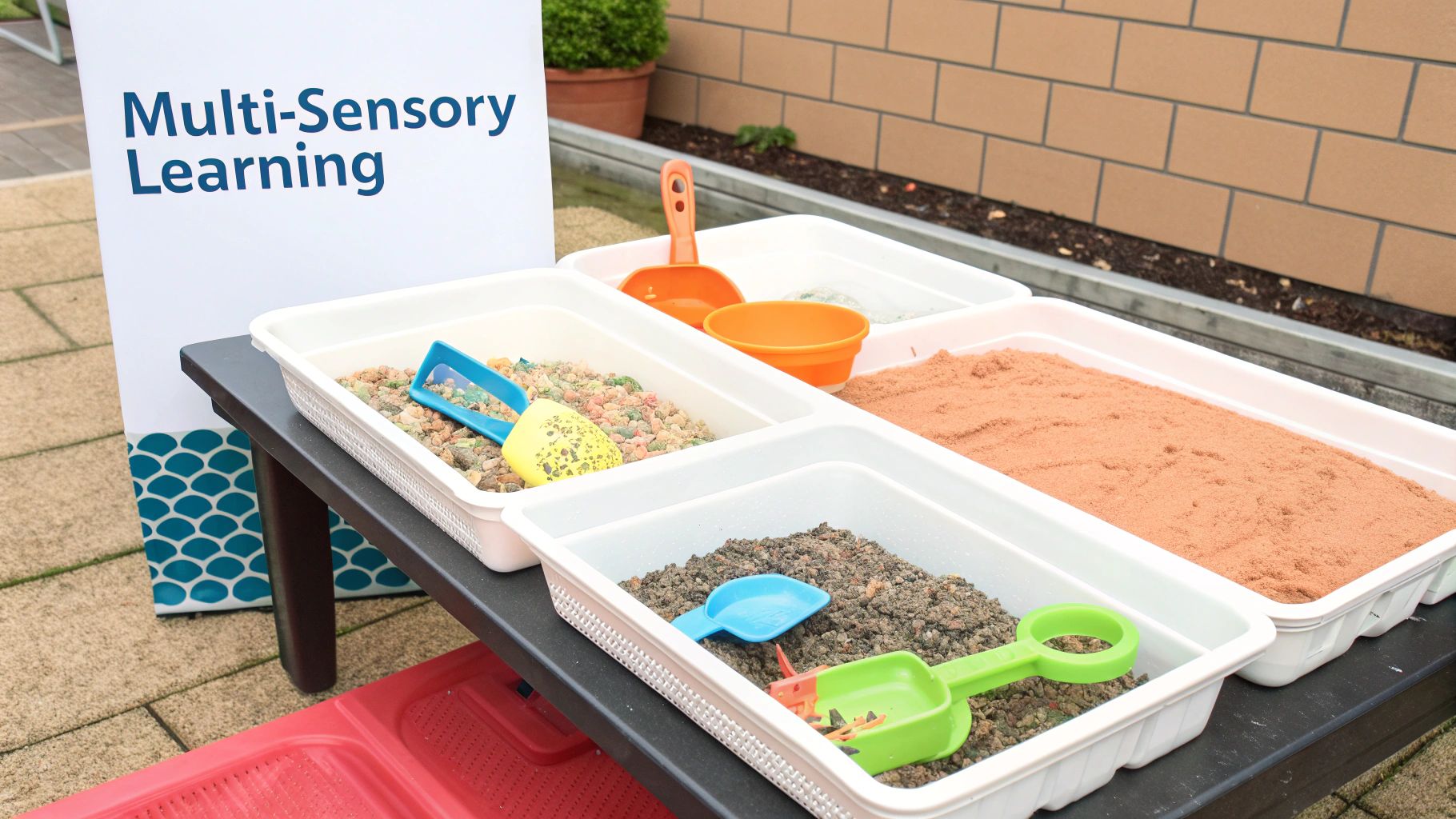
How to Foster Multi-Sensory Learning
How can you turn every learning moment into a rich, full-body experience? It's about recognizing that all children learn differently. Think of how Lunesia’s interactive stories engage both sight and sound, then add a kinesthetic layer by letting kids make choices that affect the outcome. They aren't just listening; they are doing, which is the secret sauce for deep learning.
For children who get easily overwhelmed, this method can be adapted to provide calming sensory input. This might mean having a quiet corner with soft pillows or providing sensory breaks with soothing activities.
Here’s how to bring multi-sensory learning to life:
- Make Learning Tangible: Use playdough to form letters and numbers, count with rocks or beans, or use a tray of shaving cream for writing practice. Let them feel the concepts.
- Get Moving: Act out stories, dance while you count to ten, or go on a nature scavenger hunt to find things that are rough, smooth, wet, and dry.
- Use Sound and Scent: Listen to different musical instruments when learning about cultures, use scented markers for drawing, or listen to the sounds in a story to build auditory skills.
4. Social-Emotional Learning (SEL) Integration
What if your child’s biggest tantrums could become their most powerful learning moments? That’s the promise of Social-Emotional Learning (SEL), a crucial practice that teaches children how to understand their big feelings, show empathy, and build strong relationships. This isn't about avoiding meltdowns; it’s about giving kids the tools to navigate them, turning emotional challenges into building blocks for resilience and kindness.
Did you know that organizations like CASEL have proven that SEL improves academic outcomes and long-term well-being? It’s about explicitly teaching the skills that help children succeed not just in school, but in life. Instead of just correcting behavior, we guide children to understand the why behind their feelings and actions.
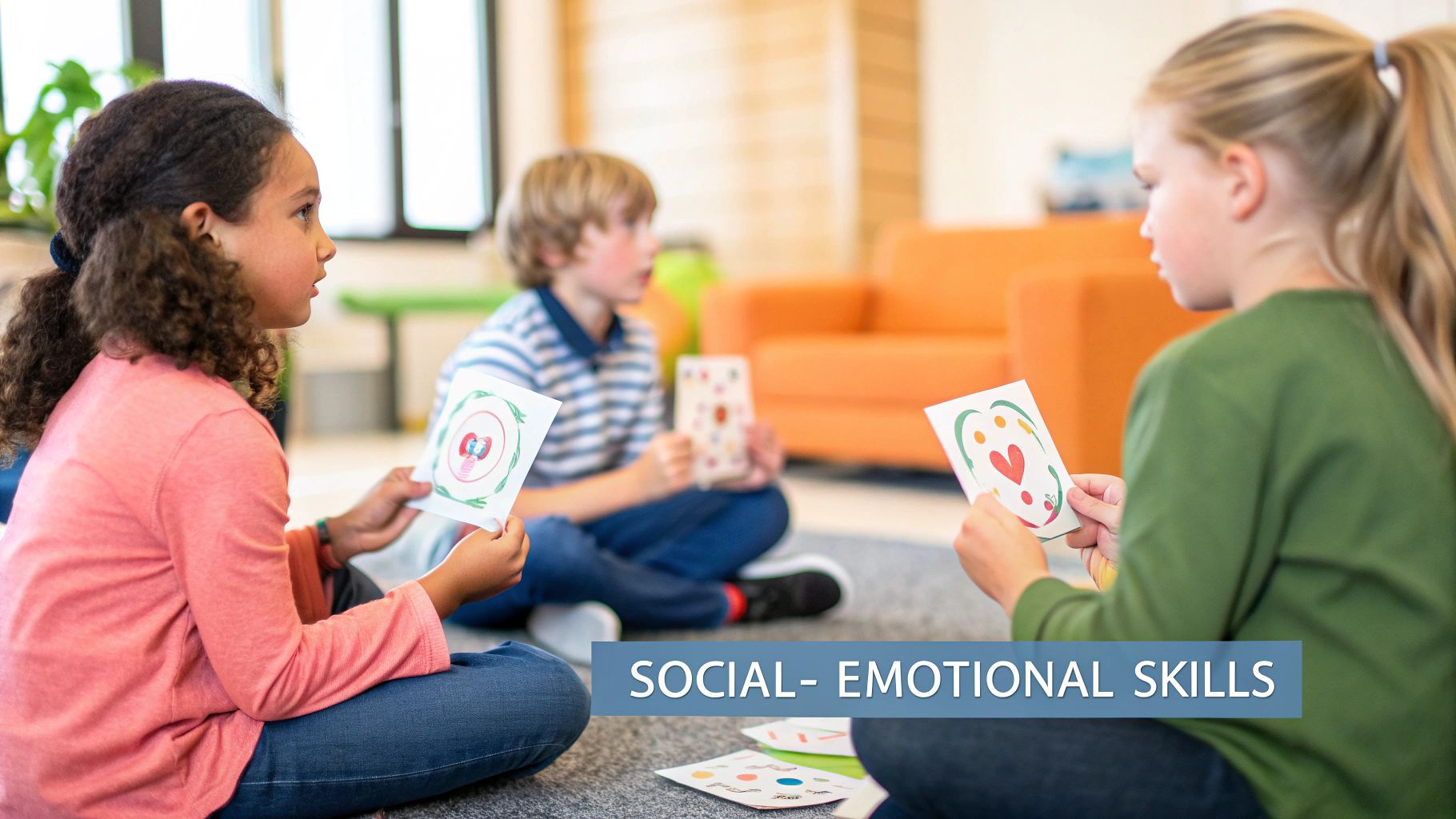
How to Weave SEL into Everyday Life
How do you teach something as complex as empathy? Effective SEL isn’t a one-off lesson; it’s woven into the fabric of daily interactions. This is where stories become your secret weapon. The interactive adventures in Lunesia are designed as emotional sandboxes. When a character is scared of the dark or nervous about a new adventure, your child doesn't just hear about it—they make choices to help that character, practicing kindness, courage, and problem-solving in a safe, fictional world. This builds the emotional muscle they need for real-life challenges.
Ready to explore more? You can find a variety of engaging emotional intelligence activities for kids to make this learning fun and interactive at home.
Here’s how to bring this powerful practice into your family’s routine:
- Be an Emotion Coach: When you're frustrated, narrate your own process. Say, "I'm feeling a little overwhelmed, so I'm going to take three deep dragon breaths to calm down. Want to do it with me?"
- Create a "Cozy Corner": Designate a space with pillows, calming toys, and pictures of different emotions where your child can go to self-soothe. It's not a time-out; it's a "calm-down" spot.
- Use Stories to Spark Discussion: Read books or engage with interactive stories where characters face social challenges. Ask questions like, "How do you think the dragon felt when his friends wouldn’t share? What could he do next time?"
5. Developmentally Appropriate Practice (DAP): Meeting Kids Where They Are
Have you ever tried to teach a three-year-old to read a novel? Of course not. Developmentally Appropriate Practice (DAP) is the formal name for this intuitive idea: tailoring learning experiences to fit a child's age, individual needs, and cultural background. This is one of the most crucial early childhood education best practices, ensuring that expectations are realistic and activities are meaningful.
Pioneered by the National Association for the Education of Young Children (NAEYC), DAP isn’t a rigid curriculum but a powerful framework. It acknowledges that a four-year-old learns differently than a six-year-old, and that two children of the same age might have vastly different skills. When we honor their unique stage, we don't just teach them; we empower them to become confident, capable learners.
How to Implement Developmentally Appropriate Practice
How can you be sure an activity isn't too hard or too easy? This approach is about being a keen observer and a flexible guide. Think of renowned Montessori or Waldorf programs, where the environment is meticulously designed to align with children’s natural developmental paths. It’s about ditching the one-size-fits-all worksheets and embracing individualized learning journeys.
Using DAP means you can provide challenges that stretch a child's abilities without causing frustration. These small, successful steps are fundamental for self-esteem. You can explore a variety of engaging ways to boost your preschooler’s confidence with activities that are perfectly matched to their level.
Here’s how to bring DAP into your daily routine:
- Be a Detective of Your Child: Observe what fascinates them, what challenges them, and what comes easily. Is your child obsessed with dinosaurs? Use that to count dinosaur toys or read stories about them.
- Adapt and Adjust: If an activity is too hard, simplify it. If it’s too easy, add a layer of complexity. For a child struggling with scissors, start with tearing paper. For a block-building master, challenge them to build a bridge that can hold a toy car.
- Offer Powerful Choices: Let them choose between two or three appropriate activities. This simple act builds their sense of autonomy. For example, ask, "Would you like to paint at the easel or build with the magnetic tiles?"
6. Inclusive Education and Universal Design for Learning
What if learning was designed from the ground up to fit every child, instead of asking children to fit the mold? That’s the core of inclusive education, powered by Universal Design for Learning (UDL). This vital approach ensures that all children, regardless of ability, background, or learning style, can thrive together.
The Individuals with Disabilities Education Act (IDEA) mandates that children receive education in the "least restrictive environment," and UDL provides the framework to make that a reality. This isn't just about adding supports; it’s about designing lessons with flexibility at their heart, so every child has a way to shine.
How to Foster an Inclusive Environment
How do you create opportunities where every child can feel successful? This approach works best when flexibility and choice are woven into the very fabric of learning. Interactive digital experiences, like the stories in Lunesia, are a great example. A child can choose how to engage with the story, making decisions that fit their comfort level and pace. This ensures a positive and empowering experience for all learning profiles, from the quiet observer to the bold decision-maker.
Here’s how to bring this inclusive method home:
- Offer Multiple Ways to Engage: When reading a story, let your child act it out, draw a picture about it, or use puppets to retell the plot. Lunesia's interactive stories do this naturally, allowing children to drive the narrative forward in a way that feels most comfortable to them.
- Provide Various Tools for Expression: Don't limit responses to just words. A child might express their understanding of a concept by building it with blocks, pointing to a picture, or using a tablet.
- Create a Predictable Routine: Use a visual schedule with pictures to outline the day's activities. This simple tool reduces anxiety and helps all children, especially those who thrive on routine, feel secure and prepared for what’s next.
7. Family Engagement and Cultural Responsiveness
What if your child’s learning environment felt like an extension of your own home and culture? That’s the power of family engagement and cultural responsiveness. This approach recognizes that you are your child's first and most influential teacher, transforming the school-home relationship into a true partnership.
Did you know that research from the NAEYC consistently shows that when schools honor a family's culture, language, and traditions, children's academic success and social-emotional well-being skyrocket? It’s about building a bridge between worlds, ensuring children see their identities celebrated and reflected.
How to Foster Partnership and Inclusivity
How can you build this bridge? This practice thrives when educators and families collaborate. Think of a classroom where family stories become part of the curriculum, or where parents are invited to share their skills, from cooking a traditional dish to teaching a song in their native language.
Building this collaborative spirit is essential for every child's success. Exploring broader principles of community engagement best practices can offer valuable strategies for enriching these vital school-home partnerships.
Here’s how to bring this powerful approach to life:
- Create a Welcoming Environment: Ensure your home library and toys reflect diverse cultures and families. Simple things like books with characters that look like your child and their friends make a huge difference.
- Share Your Family Stories: Make your family's history and traditions a regular part of conversation. Cook a family recipe together and talk about who taught it to you. This builds a strong sense of identity.
- Build a Strong Home-School Connection: Communicate openly with your child's educators. Share what your child is excited about at home, or any challenges they're facing. You are a team.
8. Inquiry-Based and Project-Based Learning: Turning "Why?" into Wonderful
What happens when a child's endless stream of "why" isn't just answered, but becomes the starting point for an adventure? That's the magic of inquiry-based learning. This approach flips the traditional model on its head, empowering children to ask questions, investigate their own interests, and dive deep into topics they genuinely care about.
This method transforms children from passive listeners into active researchers. Instead of just learning about caterpillars, they might raise them, document their transformation, and build a butterfly-friendly garden. This isn't just a science lesson; it's an unforgettable journey of discovery that builds real-world critical thinking skills.
How to Foster Inquiry-Based Learning
How do you encourage this spirit of investigation? This approach thrives on curiosity and collaboration. By following a child's lead, you are not just teaching them facts; you are teaching them how to learn. This foundation is essential for developing robust problem-solving abilities. You can learn more about how to teach critical thinking skills and nurture this vital mindset from an early age.
Here’s how to bring this powerful method into your child's world:
- Follow Their Lead: Pay attention to what sparks their interest. If they’re fascinated by the garbage truck, use it as a launchpad to explore recycling, community helpers, or how machines work.
- Set Up "Invitations to Explore": Don't just give them toys; create a scene. A collection of leaves, magnifying glasses, and paper can inspire a project on nature art or local plant life.
- Document the Journey: Use your phone to take photos or videos of their process. This validates their work and allows them to reflect on what they’ve learned, building confidence and a sense of accomplishment.
9. Formative Assessment and Documentation: Seeing Growth in Action
What if you could see your child's learning journey not as a test score, but as a rich, unfolding story? That’s the core of formative assessment. Instead of measuring what a child knows at one moment, this practice involves continuously observing and collecting "evidence" of their growth to guide their next steps.
This approach honors the idea that learning is a process, not a performance. It's about celebrating the unique way each child thinks and solves problems, providing a much richer picture than a simple checklist ever could.
How to Use Documentation to Support Learning
How do you make learning visible? It's collecting photos of a block tower, writing down a profound question a child asks, or saving a piece of artwork. These artifacts are then used to understand a child's thinking and plan supportive experiences.
For parents, this can demystify development and help you celebrate small wins. When you see progress over time, it builds your confidence as a parent and deepens your appreciation for your child's unique journey.
Here’s how to bring this practice home:
- Create a "Wow" Journal: Keep a simple notebook or a note on your phone to jot down amazing things your child says or does. It’s a powerful way to see patterns in their curiosity and growth.
- Involve Your Child: Let them choose which drawings or creations they are most proud of for a special folder. This builds their self-awareness and ownership of their learning.
- Use Photos and Videos as Conversation Starters: A quick snapshot of them explaining their Lego creation can capture far more than a written note. Show it to them later and ask, "Tell me more about what you built here!"
9 Best Practices Comparison Matrix
| Educational Approach | Implementation Complexity 🔄 | Resource Requirements ⚡ | Expected Outcomes 📊 | Ideal Use Cases 💡 | Key Advantages ⭐ |
|---|---|---|---|---|---|
| Play-Based Learning | Moderate to High – requires trained teachers | Moderate – materials and flexible spaces | Enhanced creativity, social-emotional skills, motivation | Early childhood centers, flexible curriculum | Builds critical thinking, supports varied learning styles |
| Scaffolding and Zone of Proximal Development | High – individualized support needed | Moderate to High – teacher knowledge & time | Promotes independence, metacognition, confidence | Small groups, 1:1 support, guided learning | Maximizes learning potential, encourages risk-taking |
| Multi-Sensory Learning Approaches | Moderate to High – sensory integration needed | High – diverse materials and prep | Improved retention, accommodates learning differences | Special education, mixed-ability groups | Enhances engagement, supports sensory processing |
| Social-Emotional Learning (SEL) Integration | Moderate to High – requires staff training | Moderate – materials & consistent practice | Better behavior, resilience, academic & social growth | Whole classrooms, social skills focused programs | Builds emotional regulation, reduces behavioral issues |
| Developmentally Appropriate Practice (DAP) | Moderate – based on child development knowledge | Moderate – requires planning & differentiation | Optimal development, reduced stress, individual growth | Accredited preschool programs, culturally diverse settings | Research-based, balances child/adult guidance |
| Inclusive Education and Universal Design (UDL) | High – systemic support and training required | High – adaptive tech, staffing | Equitable access, acceptance, improved outcomes | Inclusive classrooms with diverse learners | Benefits all learners, reduces stigma |
| Family Engagement and Cultural Responsiveness | Moderate – requires ongoing relationship building | Low to Moderate – flexible communication | Better academic/social outcomes, cultural validation | Diverse communities, family-centered programs | Strengthens home-school ties, builds cultural competence |
| Inquiry-Based and Project-Based Learning | High – flexible curriculum and planning | Moderate to High – varied materials & prep | Deep understanding, critical thinking, collaboration | Project-heavy learning environments | Increases motivation, promotes exploration |
| Formative Assessment and Documentation | High – ongoing observation and data use | Moderate – requires systems and tech | Authentic progress tracking, tailored instruction | Individualized instruction settings | Engages children, improves communication with families |
Your Next Adventure: Turning Principles into Practice
Navigating the vibrant, chaotic, and beautiful landscape of early childhood can feel like an epic quest. You've just explored nine powerful early childhood education best practices, but what's the single most important takeaway? It isn't about perfectly executing every strategy or turning your home into a classroom. It's about connection.
These principles are your compass, not a rigid checklist. They are tools to help you understand your child’s unique world and build a relationship founded on trust and shared discovery. When you help them with a new skill or follow their curiosity, you're sending a powerful message: "I see you. I hear you. You are capable." This is the bedrock upon which all future learning and emotional resilience is built.
From Theory to Your Living Room
So how do you make this happen when life is busy? The common thread is intentionality.
- Instead of just managing a tantrum, you see it as a chance to help your child name big feelings.
- Instead of just answering "why," you spark a project that starts with "I wonder…"
- Instead of just providing toys, you create a space that invites creativity and problem-solving.
But let's be realistic. Being this intentional 24/7 is impossible. You need moments to recharge. This is where modern tools, designed with these very principles in mind, become your greatest ally. Finding high-quality, guilt-free screen time isn't a fantasy; it's a strategic part of a balanced parenting toolkit.
Imagine your child not just watching a show, but actively shaping a story in the Lunesia app. They aren't just being entertained; they're navigating challenges, practicing empathy, and building the courage to make brave decisions in a completely safe, ad-free world. While they are immersed in a meaningful adventure, you get that precious, well-deserved moment to breathe.
This isn't about finding a digital babysitter. It’s about leveraging technology that aligns with the very early childhood education best practices we've discussed. You regain time for yourself, feeling recharged, while your child gains the skills to become the resilient, kind hero of their own life story.
Ready to give your child an adventure that builds character while you reclaim a moment of peace? Discover how the interactive stories at Lunesia bring these best practices to life, turning screen time into a powerful tool for growth and learning. Start your journey today at Lunesia.
